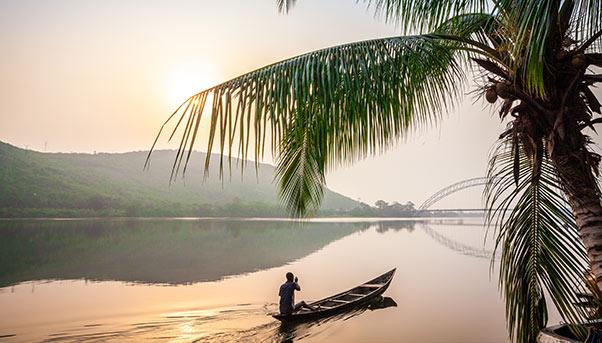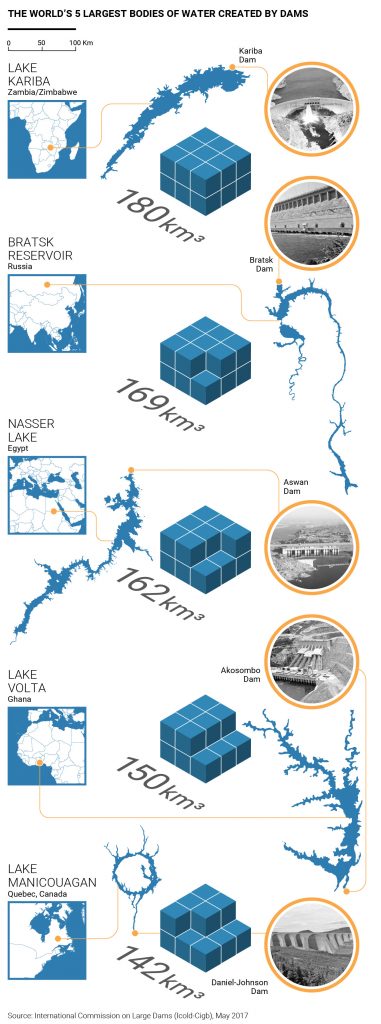
It is a paradox that will never cease to impress: the fact that some of the most invasive works on the planet do not easily reveal themselves.
It is a paradox that will never cease to impress: the fact that some of the most invasive works on the planet do not easily reveal themselves.
It is as if these enormous feats of engineering – for all their steel and concrete – are nothing more than an extension of nature.
Some dams – but, in particular, the artificial reservoirs that they create – manage to blend into their surroundings to such an extent that they become part of their environment.
It is a paradox that will never cease to impress: the fact that some of the most invasive works on the planet do not easily reveal themselves.
Lake Kariba: the world’s biggest reservoir
Lake Kariba is the largest artificial reservoir in the world by volume. Located between Zambia and Zimbabwe, it contains 180 billion cubic metres of water and covers a surface area of 5,500 square kilometres. It is 280 kilometres long and, at its widest point, spans 30 kilometres. It has 102 small islands, while the Matusadona National Park graces one of its shores.
The lake is the result of a double-arch cement dam located in a gorge along the Zambesi River. Built between 1956 and 1960 by a consortium whose members were predecessors of Salini Impregilo, the dam was the first project in Africa to be financed by the World Bank.
Such was its importance at the time that its inauguration was attended by the Queen Mother of Great Britain. Although its main purpose is to produce electricity (some 6,400 GWh a year), the lake that it created has become a veritable tourist attraction.
Bratsk reservoir: the Russian reservoir
The world’s second largest reservoir with 169 billion cubic metres of water came into being in 1967 following the construction of the Bratsk dam on the Angara River in Siberia, Russia. ùThe dam, which for a time after its construction was designated the largest in the world, inspired poet Yevgeny Yevtushenko to write about it.

Nasser Lake: the reservoir in Egypt
With its more than 160 billion cubic metres of water, Lake Nasser is the third largest reservoir, thanks to the High Aswan Dam on the Nile River in Egypt. It is 550 kilometres long and 35 kilometres at its widest point. It covers 5,250 square kilometres. It is named after Gamal Adbel Nasser, one of Egypt’s first presidents.
The dam’s construction led UNESCO to oversee a project to save the Abu Simbel temples from being submerged by the waters of the future reservoir. With contributions from 113 countries, participants in the project like Impregilo, a predecessor of Salini Impregilo, dismantled the temples and reassembled them on higher ground.
Lake Volta
Ghana is home to Lake Volta, the fourth largest artificial reservoir by volume at 150 billion cubic metres. Created by the Akosombo Dam on the Volta River, it has a surface area of 8,500 square kilometres or 3.6% of the African country’s territory.
The rockfill dam with a clay core is 134 metres high with a crest length of about 700 metres. Along the lakeshore is the Digya National Park, known for its primates, elephants and more than 230 species of birds.
Lake Manicouagan
The fifth largest body of water came into being after the construction of the Daniel-Johnson Dam in Quebec, Canada. It contains up to 140 billion cubic metres of water.
Its formation is unusual since it has the large René-Levasseur Island in the middle of it – so unusual that the ring that the water forms around the island has earned the area the nickname “Eye of Quebec”. The dam itself is a record-maker. It is the highest multiple-arch-and-buttress dam in the world.

